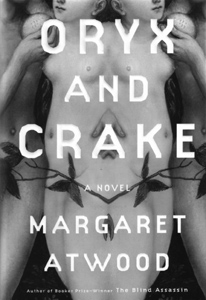![[Metroactive Books]](/gifs/books468.gif)
[ Books Index | Santa Cruz | Metroactive Home | Archives ]
Margaret Atwood goes heavy on the bioethics in the otherwise entertaining 'Oryx and Crake'
By Asher Brauner
Walk into any local bookstore, and you will look in vain for a thicket of thorny blackberry bush separating the fiction and science fiction aisles. Yet many readers of literature seem unwilling to cross those few frightening feet to the Land of Speculation.
In 1985, however, Margaret Atwood sent many venturing across the forbidding divide with The Handmaid's Tale. Nearly 20 years later, she's at it again with Oryx and Crake (Doubleday; 400 pages; $26 cloth), a compelling new novel that beckons across the aisle once again. I highly recommend you follow her there.
Oryx is being marketed as a companion--a handmaid, if you will--to The Handmaid's Tale. There are clear parallels. Both books are set in the near future in an unnamed setting, and both feature very plausible dystopias--Handmaid saw the oppression of Western women degenerating into a disturbing reversion to the worst of Old World patriarchy, while Oryx examines the future of biotechnological genetic meddling, and doesn't like what it sees.
As always, Atwood's writing is superb. Her attention to detail and her love of language make this novel a pleasure to read. She creates a believable universe, and that alone is worth the price of admission. The bad news is: Oryx is too simple a book to be set in the near future.
The purpose of all readable fiction set in the future is to warn us about the folly of our present ways. The perennial difficulty of this genre is that any novel that overdoes it is unpleasantly didactic. There are two standard solutions to this problem: create compelling characters, and invest your work with nuance. Atwood is much better at the former than the latter.
The lead character of Oryx, though, is a very enjoyable creation that redeems the book's other weaknesses. When we first meet him, he's a crotchety half-drunk known as Snowman, who would not seem out of place parked on a Pacific Avenue bench. He is either the last man alive, or thinks he is--is there a difference?
Well before this, we learn, he was innocent "Jimmy," born into a wealthy family in an enclave hidden away from a nasty citified postmodern world and all its germs. As a young adult, he shouldered a melancholy that endeared him to an impressive procession of sex partners. Unfortunately, he was bereft of scientific inclination, and the only way he could make a buck was to work--and this is possibly the worst horror--in advertising.
Jimmy's lifelong best buddy is a gene-splicin' genius named Crake, who masterminds a plan that will either save or doom the human race, depending on who's keeping score--Frankenstein Crake, or his hired ad-man, Jimmy. Representing opposing points of view, they also compete over the same gorgeous woman, and isn't that a fresh setup?
With considerable tweaking of human biology, taking out some of the brains and adding in sexual satisfaction, Crake aims to eliminate disease, wars, sexism, racism, hierarchy, competition for scarce resources and singles bars.
Doesn't that sound good? Not to me, either. That's Atwood's greatest weakness, siding too strongly with one side of an intriguing argument. She might as well have titled the book Don't Mess With the DNA or Bad Things Will Happen. It would be easier to spell, for one thing.
In the real world, biomeddling is zipping along, and people of goodwill are of two minds about it: we like any medical intervention that helps us, but we're horrified when it seems freakish. Almost any medical intervention begins with the noble ambition of reducing suffering, yet each can also be viewed as unnatural. The clash of viewpoints can create some fascinating arguments about body, identity and the destiny of the species, but Atwood casually sidesteps these considerations in favor of a highly entertaining read.
2003 Summer Lit Issue:
[ Santa Cruz | Metroactive Central | Archives ]
Copyright © Metro Publishing Inc. Maintained by Boulevards New Media.
Buy 'Oryx and Crake' by Margaret Atwood
![]()

Frankenstein Must Be Destroyed
![[line]](/gifs/line.gif)
Jessica Neuman Beck's top 10 personal favorite books
'Living History' by Hillary Rodham Clinton
'Get Your War On' by David Rees
'Harry Potter and the Order of the Phoenix' by J.K. Rowling
Harry Potter slash fiction
'Beyond Belief' by Elaine Pagels![[line]](/gifs/line.gif)
From the July 16-23, 2003 issue of Metro Santa Cruz.